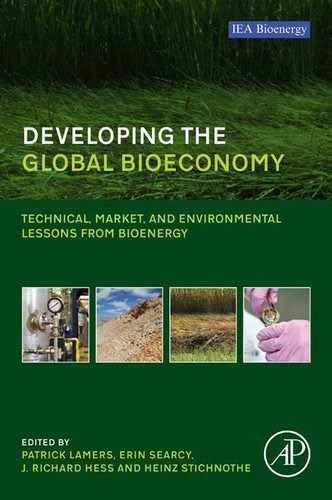Index
Note: Page numbers followed by “f” and “t” refer to figures and tables, respectively.
A
Accellerase Duet product, 23–24
Acrolein, 30
Actinobacillus succinogenes, 26–27
Advanced biohydrocarbons, 28
Agricultural and Fisheries Council of the European Union, 81–82
Agricultural residues-based supply chains, 106–108
corn and wheat residue costs at farm gate, 106–107
American Association of Cost Engineers, 43
Amyris, 28
Anaerobic digestion (AD), 14–15
Anaerobiospirillum succiniciproducens, 26–27
Anthropogenic greenhouse gas (GHG) emissions, 2
Arundo donax, 58
ASPEN PLUS, 49
B
BHP Billiton, 144
Biobutanol, 27
Biochemical conversion, 57–58
bioethanol production, 58
Biochemical pretreatment, 18–20
defined, 2
in IEA Bioenergy member countries, status of, 3–7
Bioethanol
production, 58
Biofuels, value chain of, 74f
Biomass
conversion technologies for, 14f
herbaceous, 94–95
markets, commoditization of, See Commoditization of biomass markets
preprocessing methods, 15–18
supply and demand centers, 92–95
woody, 94–95
Bio-oil
characteristics, 33–35
viscosity of, 34–35
wood-derived crude, properties of, 34t
Biopower markets, development of, 95–96
demonstration and full-scale plants, 53–63
economic considerations for, 43–49
energy-driven, 70
product-driven, 70
BP, 146
BTG BioLiquids BV (BTG-BTL), 57
2,3-Butandiol (BDO), 27
C
Capital expenditures (CAPEX), 43
Carbohydrate content, role in biochemical conversion process, 17
Cellulose, saccharification of, 20–24
Chemical pretreatment, 18–20
Circular Economy Plan, 84–85
Clostridium beijerinckii, 27
Commodities, defined, 141–145
Commoditization of biomass markets, 139
characteristics of, 158–159
crude oil market, 145–148
analysis of, 148
commoditization of, 145–147
futures contracts, 145
failure of, 157–158
goods, properties of, 141–142
homogeneity, 150
international market integration, 155–156
market liquidity, 154–155
market-related properties, 143–145
obstacles to
market-related, 159–161
policy-related, 159
product quality, 150–152
standardization, 150–151
sustainability, 152–153
traceability, 152–153
Commodity-scale biomass trade, 115
future trends of, 135–136
leveraging gas handling infrastructure, 132–135
leverage liquids handling infrastructure, 129–132
leveraging solids handling infrastructure, 122–129
forest biomass, shipping of, 128–129
recommendation for, 135–136
Composite residue logs (CRL), 126–127
Composting, 14–15
Consolidated bioprocessing (CBP), 25–26
Corn residue costs
at farm gate, 106–107
Council on Sustainable Biomass Production (CSBP), 73
Crude oil, 131
market, 145–148
analysis of, 148
commoditization of, 145–147
D
Depot
configurations and evolvement, 172–174
early-stage, 172–173
later-stage, 173
deployment, 174–176
mobilization gridlock via merchandisable intermediates for multiple markets, overcoming, 174–175, 174b
vertical supply chain, separating, 175–176
Dilute acid hydrolysis, 19
DSM, 23–24
Dyadic, 23–24
E
EMPYRO, 57
Energy crop-based supply chains, 99–104
Energy-driven biorefineries, 70
Ensyn Corp, 54–55
Enterobacter aerogenes, 27
European Commission (EC)
bioeconomy strategies, 3
European Committee for Standardization (ECN), 73–74
European Union (EU), 120
Action Plan for the Circular Economy, 81
ecolabel, 84–85
Renewable Energy Directive (RED), 73
Exponential method, 45–49
F
Factorial method, 44–45
demonstration and full-scale plants, 53–57
Ensyn Corp, 54–55
BTG BioLiquids BV, 57
EMPYRO, 57
reactors, 32
Feedstock matrix, 13–36
Final conversion facility, location of, 98–99
First-generation biofuels and bioenergy crops, 75–77
Fixed capital investment, 43
Food-grade L-methionine, 30
Forest biomass, shipping of, 128–129
Forest Stewardship Council (FSC), 73
Fossil fuels, value chain of, 74f
Fractionation, 19
Futures contracts, 145
failure of, 157–158
G
Genencor, 23–24
Glencore, 144
Global Bioenergy Partnership, 73
Glycerol
catalytic dehydration of, 30
Hardwoods, 19–20
Hemicellulose
pretreatment of, 19
saccharification of, 20–24
Herbaceous biomass, 94–95
3-Hydroxypropionicacid, 58–60
I
bioeconomy strategies across, 3
Inside battery limits (IBL), 43
Integrated lifecycle sustainability assessment (ILCSA), 74–75
Intermediate goods, commodity for, 148–150
International Maritime Organization (IMO), 123
International market integration, 155–156
International trade of biomass, 95–104
biopower markets, development of, 95–96
energy crop-based supply chains, 99–104
final conversion facility, location of, 98–99
Investment costs, 43–44
K
Klebsiella oxytoca, 27
Klebsiella pneumoniae, 27
L
Lactic acid, 27
Lactobacillus delbrueckii, 27
Leverage liquids handling infrastructure, 129–132
Leveraging gas handling infrastructure, 132–135
Leveraging solids handling infrastructure, 122–129
forest biomass, shipping of, 128–129
Lifecycle analysis, 74
Lignin content, role in biochemical conversion process, 17
Lignocellulose, 15
pretreatment of, 19
saccharification of, 23
Liquid hot water, 19–20
Local/regional trade of biomass, 104–108
M
Market structure, 153–154
Market transition, 176–183
periods, 176–177
supply chain opportunities, 179–182
Microbial lipids, 28
Minimum fuel selling price (MFSP), 167
N
Novozymes, 23–24
O
Operating expenditure (OPEX), 43
Operation costs (OC), 46
Organic Farming Regulation, 15
Outside battery limits (OBL), 43
P
Paenibacillus polymyxa, 27
Palm fatty acid distillate (PFAD), 28
Physical pretreatment, 18–20
Preprocessed biomass for power generation, biomass supply and trade opportunities of, 91
international trade, 95–104
biopower markets, development of, 95–96
energy crop-based supply chains, 99–104
final conversion facility, location of, 98–99
local/regional trade of biomass, 104–108
Preprocessing, 96–98
hydrothermal carbonization, 91
pelleting, 97
technologies, 15–18
basic methods, 15–18
densification, 18
thermal pretreatment, 18
torrefaction, 97
Pretreatment, 18–20
Pricing, 176b
Product costs (PC), 46
Product-driven biorefineries, 70
Product quality, 150–152
R
REACH (Registration, Evaluation, Authorization & restriction of Chemicals), 124–125
Revenue (R), 46
Rio Tinto, 144
S
Saccharification, of cellulose/hemicelluloses, 20–24
Second-generation biorefineries, development of, 11
anaerobic digestion, 14–15
cellulose/hemicelluloses, saccharification of, 20–24
composting, 14–15
preprocessing technologies, 15–18
basic methods, 15–18
densification, 18
thermal pretreatment, 18
pretreatment, 18–20
thermochemical conversion, 30–36
Separate hydrolysis and fermentation (SHF), 25–26
Shrinkage, 15–16
Silphium perfoliatum, 15
Simultaneous saccharification and cofermentation (SSCF), 25–26
Solid biomass, standards for, 117t–118t
Sorbitol, 28
Standardization, 150–151
Steam explosion, 19–20
Step accounting method, 45
Sustainability, 152–153
challenges to, 77–82
first-generation biofuels and bioenergy crops, 75–77
future assessment considerations in bioeconomy sector, 82–85
methodologies and frameworks, overview of, 72–75
recommendations for, 85–86
Sustainable Forestry Initiative (SFI), 73
T
Thermal pretreatment, 18
Traceability, 152–153
Transportable biomass, properties of, 125t
Trichoderma longibrachiatum, 23
Trichoderma viride, 23
U
UN Sustainable Development Goals, 82
US. Biorefining, 6–7
US Renewable Fuel Standard (RFS2), 120–121
V
Vertical supply chain, separating, 175–176
W
Wet oxidation, 19–20
Wheat residue costs, at farm gate, 106–107
Woody biomass, 94–95
X
Xstrata, 144
Xylitol, 28
Z
Zymomonas mobilis, 28
..................Content has been hidden....................
You can't read the all page of ebook, please click here login for view all page.
